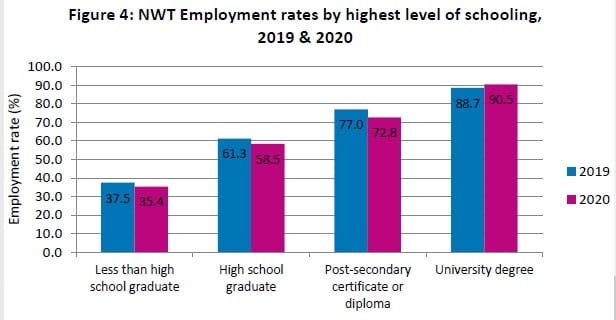The December employment rate in the NWT reached 65 per cent, the highest level of any month in the year, the NWT Bureau of Statistics found in its latest Labour Force Activity report, issued Friday.
The 65 per cent employment rate bested the 64.4 per cent rate reported in November, when 20,500 people were employed. The latest rate marks an increase of 700 people.
The rise is also 1.5 per cent higher than the rate for December 2019.

GNWT image
Demographically, the largest job gains for December 2020 were among Indigenous people and those living outside Yellowknife, by 7.3 and 6.3 percentage points, respectively.
The territory's employment rate rose steadily since June, in line with the loosening of Covid-19 restrictions.
The employment rate in June was a record low, falling to 60.6 per cent after three consecutive months of declines.
Nationally, the NWT's employment rate in December was the second highest after the Yukon, where it was 66.4 per cent. Saskatchewan's rate of 62.6 per cent was the third highest and Alberta's rate of 61.9 per cent was the fourth highest.
However, 2020 as a whole brought the lowest employment rate since 2011. The best year within that span was 2012, when it registered at 71.3 per cent.
"The coronavirus pandemic saw the employment rate falling 2.6 percentage points to 63.1 per cent. In Canada, it led to the largest year-over-year percentage point drop (-4 per cent) in the employment rate during the past 20 years," the report stated.
In 2020, employment rates differed significantly between people with less than high school education (35.4 per cent) and those with university degrees (90.5 per cent).
"Employment rates in the NWT demonstrate the strong association between educational attainment and employment. Between 2019 and 2020, employment rates declined for persons in all educational attainment categories, except for those with a university degree," the report said.
The main employment declines by sector in 2019 were in health care and social assistance; information, culture and recreation; and in forestry, fishing, mining, oil and gas. Gains in public administration, construction and other services weren't able to offset job losses in the other industries.
